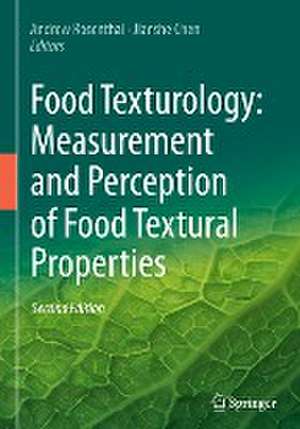Food Texturology: Measurement and Perception of Food Textural Properties
Editat de Andrew Rosenthal, Jianshe Chenen Limba Engleză Hardback – 21 dec 2023
Preț: 606.50 lei
Preț vechi: 713.53 lei
-15% Nou
Puncte Express: 910
Preț estimativ în valută:
116.05€ • 126.46$ • 97.79£
116.05€ • 126.46$ • 97.79£
Carte tipărită la comandă
Livrare economică 23 aprilie-07 mai
Preluare comenzi: 021 569.72.76
Specificații
ISBN-13: 9783031418990
ISBN-10: 3031418999
Pagini: 464
Ilustrații: XIV, 464 p. 174 illus., 119 illus. in color.
Dimensiuni: 178 x 254 mm
Greutate: 1.04 kg
Ediția:2nd ed. 2024
Editura: Springer International Publishing
Colecția Springer
Locul publicării:Cham, Switzerland
ISBN-10: 3031418999
Pagini: 464
Ilustrații: XIV, 464 p. 174 illus., 119 illus. in color.
Dimensiuni: 178 x 254 mm
Greutate: 1.04 kg
Ediția:2nd ed. 2024
Editura: Springer International Publishing
Colecția Springer
Locul publicării:Cham, Switzerland
Cuprins
Introduction to the Measurement of Sensory and Instrumental Food Texture.- Food structure as a foundation for food texture.- Food Texture Diagrams and Maps.- Oral Physiology and Mastication.- Psychophysics of texture perception.- Sensory scaling and measuring techniques.- The Meaning of Sensory and Consumer Terminology.- Consumer perception of food texture in relation to preferences and food intake.- Texture Analysers.- Rheometry and Rheological Characterisation.- Tribometers for studies of oral lubrication and sensory perception.- New in vitro and in situ instrumental approaches for food texture research.- Texture of vegetables and fruit.- Texture of Bakery Products.- Meat and reformed meat products.- Texture of Fish and Fish Products.- Texture of Dairy products.- Candy Texture (Sugar Confectionery).- Starch, modified starch and extruded foods.- Hydrocolloids as Texture Modifiers.- Textural Aspects of Special Food for Dysphagia Patients.
Notă biografică
Andrew Rosenthal’s research interests are centred on food texture and its measurement. He has published widely with around forty research articles, as well as four books. Before the pandemic, Andrew was an Associate Professor in Food Science at the University of Nottingham, though now he has retired and lives in Baiersbronn, Germany, with his wife Sheila and four dogs.
Jianshe Chen is a specially appointed professor at Zhejiang Gongshang University, Hangzhou, China. During his early years at the University of Leeds, UK, Prof. Chen pioneered research in food oral processing. His current study focuses on the fundamental principles of eating and sensory perception by applying a combined approach involving food physics, oral physiology and sensory psychology. Prof. Chen has published four books and authored nearly 200 research papers.
Textul de pe ultima copertă
The concept behind this book is to take a holistic view of food texture, starting with the determination of food texture, its perception in the mouth, and its measurement by both sensory and instrumental methods, and to examine the relation between them. The book has been divided into four sections: Fundamentals, Sensory and Human Interactions, Instrumental Analysis, and Food Products. Essentially we cover the techniques used for measuring food texture, and then apply them to the different product groups.
Readers of the first edition will notice the title has changed, with the adoption of the term texturology. In the long history of food texture research, texturology has been occasionally used in literature. The term texturology has not been widely accepted by texture researchers (texturologists) because of their concern over whether the theories and techniques are broad and strong enough to support texture research as a scientific discipline. During the 24 years since the publication of the first edition, the editors have observed vast developments in theories as well as the assessment methodology of food texture (both sensory and instrumental) and these have shaped our understanding. This second edition brings the science up to date by introducing topics not previously covered (e.g. psychophysics, tribology, oral processing, texture maps and special foods for dysphagia patients). It includes an exposé of the instruments to measure food texture, and also considers techniques for measuring consumer perception of food texture (in addition to the sensory properties). Additionally, it amends omissions from the first edition such as dairy products; fish; bakery products; and, sugar confectionery, asproduct groups. All in all it is expanded and updated in its coverage of food texturology, as a coherent scientific discipline.
Caracteristici
Endorses the term “food texturology” as a scientific discipline, in its own right Brings together sensory and instrumental measurements of food texture in the context of real food products Expands and updates coverage from the first edition with new topics
